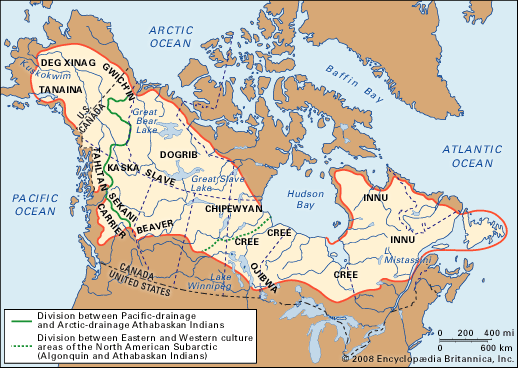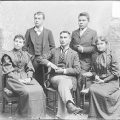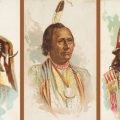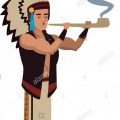
The Subarctic Culture Area lies south of the Arctic Circle and covers some 12 million square miles. It spreads from the interior of Alaska to the Atlantic Ocean. This is an area where the winters are cold – often colder than in the Arctic – and the summers are short. During the summer, the blackflies and other insects make life difficult. A frost-free period of only 40-60 days is common in much of the region.
Linguistically, the Subarctic can be broken into two areas: (1) the area west of Hudson’s Bay in which Athapascan languages predominate, and (2) the area east of Hudson’s Bay in which the people spoke Algonquian languages. Culturally, however, it may be more convenient to look at these culture areas as being composed of three sub-areas: (1) the northeastern area (the area east of Hudson’s Bay) which was traditionally occupied by the Algonquian-speaking Montagnais and Naskapi, (2) the central zone which was occupied by the Algonquian-speaking Cree, and (3) the northwest which was occupied by the Athapaskan-speaking tribes.
With regard to the native people of the Subarctic, John J. Collins, in his book Native American Religions: A Geographical Survey, writes:
“These people had been in North America for a long time and had been pushed into the Subarctic by related groups to the south.”
The tribal names used today do not reflect the significant territorial entities of earlier times. June Helm and Eleanor Leacock, in North American Indians in Historical Perspective, write:
“Large areas were inhabited by small autonomous regional groups that commonly number a few score members each. They were usually loosely related to surrounding groups through intermarriage, economic dependence in times of local scarcities, linguistic affinity, and some feeling of ethnic identity.”
The primary form of subsistence among the Subarctic tribes was hunting. It is estimated that during the winter people needed to consume 4,500 to 5,000 calories per day. Each person might consume four pounds of meat per day.
Large game animals, such as the moose, elk, musk ox, caribou, and deer, were of primary importance. In his book Native Arts of North America, Christian Feest writes:
“The tribes of the Subarctic had always been nomadic hunters of the moose, caribou, and other animals of the northern forests.”
In some areas, the people hunted wood buffalo (bison bison athabascae) and plains buffalo (bison bison bison). Large game animals were generally hunted with a bow and arrow or were trapped using deadfalls. Hunters would use calls for bringing in moose during mating season. In some areas, caribou were driven toward long brush fences where they were forced into single file and could be more easily killed.
The caribou was particularly important to many of the tribes. Colin Taylor, in his book Native American Hunting and Fighting Skills, reports:
“The caribou was essential to the sustainment of life amongst such tribes as the Athapascan speaking Chipewyan.”
Among the Chipewyan, the communal caribou hunt used a pound technique in which the herd would be driven into a chute made of poles and brush. Within the enclosure—which could be over a quarter of a mile in diameter—were looped snares which entangled the animals so that they could be easily dispatched. Philip Kopper, in his book The Smithsonian Book of North American Indians: Before the Coming of the Europeans, reports:
“From the caribou, the people obtained food, hides and material for many implements from bones for netting needles to rawhide for fishlines and thongs. They ate the meat fresh or they preserved it by sun-drying or smoking, then pounding it into powder and mixing it with fat to make pemmican.”
Some of the other animals which were hunted in this area include bear, beaver, porcupine, and rabbit. With regard to hunting bears in the Shield and Mackenzie Border lands, Edward Rogers and James Smith report in the Handbook of North American Indians:
“Although bears were found throughout the forests, they were not taken frequently enough to bulk large in the diet; however, they were eagerly sought especially for the large quantities of fat they possessed.”
Rabbits were often snared by the women. The smaller animals – beaver, rabbits – were often taken with traps and snares. While the snowshoe rabbit is widely exploited in the Subarctic Area, Beryl Gillespie, in the Handbook of North American Indians, reports:
“While not a preferred source of food for many natives, it has been a very important source of midwinter food when large game is difficult to find or kill.”
Among the Natives, it was felt that one could starve to death on rabbits as they provided very little fat during most of the year.
In the eastern portion of the region, beaver were taken as a food source, particularly in winter. To capture the beaver, nets would be placed across the entrances to the beaver lodges.
In the Hudson Bay Area, migratory waterfowl was an important food resource. Various species of grouse were also taken throughout the Subarctic area.
In some areas, fishing was also an important subsistence activity. Fish were caught using lines and hooks or they were netted in gill nets woven from raw hide or the inner bark of the willow. In some areas, fish traps and weirs were also used.
In some areas, the Native people relied heavily on the seasonal salmon runs. In the lake areas of the western Labrador interior, whitefish and lake trout were the most desirable fish. In addition, the general availability of fish in most lakes and streams made fishing a seasonally important activity.
Among the Montagnais off the Saint Lawrence region, fresh eels were taken in September and October. Edward Rogers and Eleanor Leacock report in the Handbook of North American Indians:
“Chains of stones were laid in the sand at the river edge to guide eels, when waves lashed the shore, into weirs large enough to hold 500-600. Eels were also attracted to canoes at night with torches and speared with iron-pointed leisters.”
With regard to the gathering of wild plants, June Helm and Eleanor Leacock write:
“Plant foods were inconsequential in the diet, though blueberries, cranberries, and edible shoots and bulbs were collected in the summer.”
Canoes were important to many of the tribes of this culture area. During the summer, travel was possible via lakes and rivers using canoes. Writing about the Cree, archaeologist Dale Russell, in his book Eighteenth-Century Western Cree and Their Neighbours, says:
“Women were often more skilled in steering canoes than men since the latter typically rode in the bow where they had an unimpeded aim at any game that was met.”
In the western portion of the Subarctic Culture Area, people used canoes which resembled the Inuit kayak. However, instead of covering the frame with skin in the Inuit style, the frame was covered with birchbark. This made the craft very light and enabled the people to carry it over long distances.
The Chipewyan made a birch bark kayak-style canoe which was used in hunting caribou or moose as they crossed rivers or lakes. According to John Jennings in his book Bark Canoes: The Art and Obsession of Tappan Adney:
“The canoe was extremely responsive and could be steered with one hand as the other was busy with spear or knife.”
The Gwich’in also made birch bark canoes. John Jennings reports:
“The Gwich’in canoes are unique among Northwestern canoes in having a rigid frame, with the stringers held in place by crosspieces.”
With regard to the Gwich’in canoes in the Tanana River area, Jennings writes:
“These canoes were subtly asymmetrical, being slightly wider and deeper at the stern, thus making them both very fast and easy to maneuver. The lightness of the bow allows it to hydroplane when driven fast.”
During the winter, snow shoes were used. Again, the travel routes often utilized the frozen lakes and rivers. Among the Montagnais-Naskapi, long, narrow toboggans would be pulled with a cord across the chest. Edward Rogers and Eleanor Leacock report:
“They were ideal when everything was covered with deep snow, for their relatively extensive weight bearing surface prevented them from sinking too deeply into the powdery snow.”




Leave a Reply